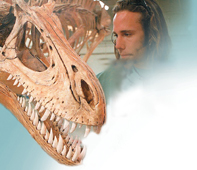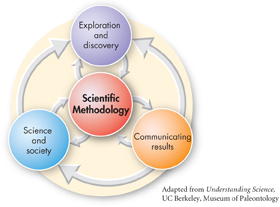
1.2 Science in Context
 What scientific attitudes help generate new ideas?
What scientific attitudes help generate new ideas? Why is peer review important?
Why is peer review important? What is a scientific theory?
What is a scientific theory? What is the relationship between science and society?
What is the relationship between science and society?
theory • bias
Preview Visuals Before you read, study Figure 1–10. As you read, use the figure to describe the role science plays in society.
THINK ABOUT IT Scientific methodology is the heart of science. But that vital “heart” is only part of the full “body” of science. Science and scientists operate in the context of the scientific community and society at large.
Exploration and Discovery: Where Ideas Come From
 What scientific attitudes help generate new ideas?
What scientific attitudes help generate new ideas?
Scientific methodology is closely linked to exploration and discovery, as shown in Figure 1–5. Recall that scientific methodology starts with observations and questions. But where do those observations and questions come from in the first place? They may be inspired by scientific attitudes, practical problems, and new technology.
Scientific Attitudes Good scientists share scientific attitudes, or habits of mind, that lead them to exploration and discovery.  Curiosity, skepticism, open-mindedness, and creativity help scientists generate new ideas.
Curiosity, skepticism, open-mindedness, and creativity help scientists generate new ideas.
▸ Curiosity A curious researcher, for example, may look at a salt marsh and immediately ask, “What's that plant? Why is it growing here?” Often, results from previous studies also spark curiosity and lead to new questions.
▸ Skepticism Good scientists are skeptics, which means that they question existing ideas and hypotheses, and they refuse to accept explanations without evidence. Scientists who disagree with hypotheses design experiments to test them. Supporters of hypotheses also undertake rigorous testing of their ideas to confirm them and to address any valid questions raised.
▸ Open-Mindedness Scientists must remain open-minded, meaning that they are willing to accept different ideas that may not agree with their hypothesis.
▸ Creativity Researchers also need to think creatively to design experiments that yield accurate data.

FIGURE 1–5 The Process of Science As the arrows indicate, the different aspects of science are interconnected—making the process of science dynamic, flexible, and unpredictable.

Table of Contents
- Formulas and Equations
- Applying Formulas and Equations
- Mean, Median, and Mode
- Estimation
- Using Measurements in Calculations
- Effects of Measurement Errors
- Accuracy
- Precision
- Comparing Accuracy and Precision
- Significant Figures
- Calculating With Significant Figures
- Scientific Notation
- Calculating With Scientific Notation
- Dimensional Analysis
- Applying Dimensional Analysis




